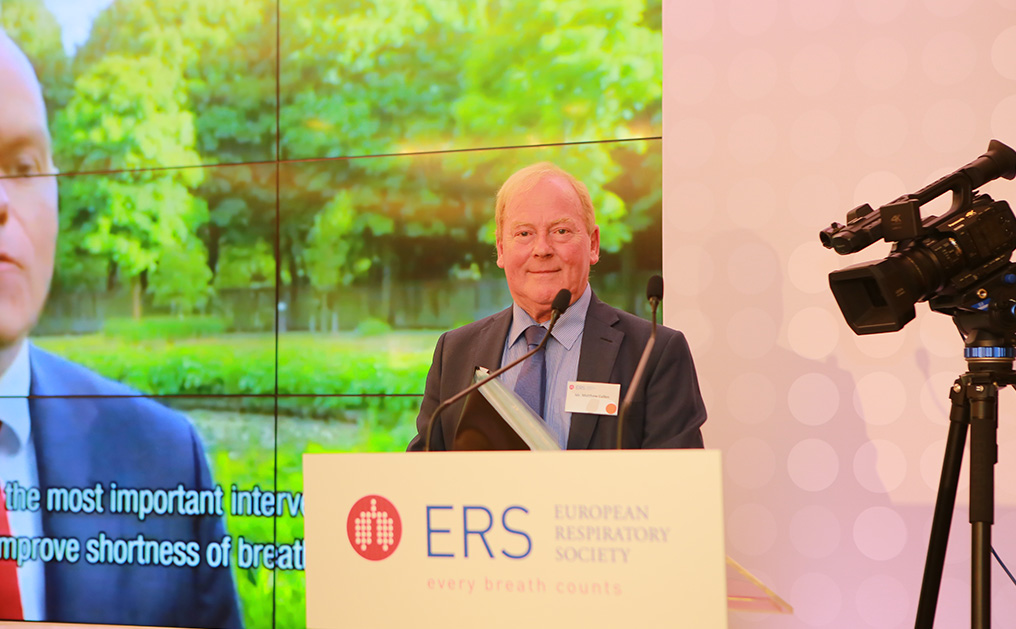Interstitial lung disease (ILD)
Interstitial lung diseases (ILDs), also known as diffuse parenchymal lung diseases, are a group of diseases affecting the lungs. The diseases cause damage to the cells surrounding the alveoli (air sacs) leading to widespread inflammation and fibrotic scarring of the lungs.
Conditions
There are more than 300 different conditions that are classed as interstitial lung diseases. Most are very rare; but the more common interstitial lung diseases include:
- Sarcoidosis
- Idiopathic pulmonary fibrosis
- Extrinsic allergic alveolitis (also known as hypersensitivity pneumonitis)
- Interstitial lung disease associated with connective tissue disease (CTD-ILD). This can also be known as Interstitial Lung Disease associated with Systemic Autoimmune Rheumatic Diseases (SARD-ILD)
- Pneumoconiosis
- Interstitial lung disease caused by certain drugs used to treat other conditions
- Cystic lung disease such as lymphangioleiomyomatosis (LAM), pulmonary Langerhans cell histiocytosis (PLCH), and Birt-Hogg-Dubé syndrome.
Some interstitial lung diseases, particularly sarcoidosis, also affect other organs in the body.
Research into the prevalence of interstitial lung diseases is difficult as specific diagnoses are not always obtained . Some studies suggest that when cases of idiopathic pulmonary fibrosis and sarcoidosis are added together, they account for 50% of all interstitial lung diseases.
Experts class interstitial lung diseases into two groups: diseases that have a known cause and those where the cause and origin of the disease is unknown.
Symptoms
In interstitial lung disease (ILD), the lungs become inflamed and scarred over time. This scarring makes the lungs stiff and less able to take in oxygen from the air you breathe.
Symptoms usually develop gradually and can vary depending on how much of the lung is affected. Most people with ILD feel short of breath, especially when walking or exercising, and often feel very tired (fatigue). A dry, persistent cough is also common. In later stages of the disease, the low oxygen levels in the blood can cause a bluish or purplish colour around the lips, hands, or feet, and the fingertips may become swollen or rounded (a condition called clubbing).
Causes
Only about one in three cases of interstitial lung diseases has a known cause. Experts believe that a combination of genetics, which make people susceptible to the condition, and environmental factors may explain the development of some conditions, including sarcoidosis. Environmental factors have been recognised in 35% of people with interstitial lung disease.
Pneumoconiosis is due to inhaled agents in the workplace, which provoke widespread scarring and hardening (fibrosis) of the lungs. The classical causes are silica dust (silicosis), coal dust (coal workers’ pneumoconiosis) and asbestos (asbestosis). These conditions have become less common due to changes in industrial practices.
Extrinsic allergic alveolitis is due to an allergic reaction to any of several inhaled organic agents; the more common causes include exposure to the dust from mouldy hay (farmer’s lung) or from pigeons or caged birds (bird fancier’s lung).
Certain drugs taken as medication for other conditions can also cause interstitial lung disease. The most common examples are: amiodarone (used to treat an irregular heartbeat), bleomycin (a chemotherapy drug), and nitrofurantion (used to treat urine infections).
In some cases, lung issues develop because of an underlying condition like rheumatoid arthritis, scleroderma, or lupus.
Prevention
Prevention of interstitial lung diseases can only be achieved when the cause is known. In these cases avoiding exposure to the relevant environmental risk factor is the best method of prevention, for example with occupational diseases.
In the future, experts hope to be able to identify which people are more susceptible to developing an interstitial lung disease as this will help them provide individual preventative measures for each person.
Diagnosis
Essential investigations include imaging of the lungs by chest radiography and computed tomography (CT) scanning. Typical appearances of interstitial lung disease include widespread fine nodules, a net-like pattern or a general haziness. High resolution CT scans can be used to help define the specific type of interstitial lung diseases by looking at the type and spread of the lung shadowing on the image.
In advanced lung fibrosis the lungs may have a ‘honeycomb’ appearance due to extensive destruction of the alveoli and development of small cystic spaces within the lung.
Lung function testing and oxygen levels in the blood are also important for diagnosis and monitoring progress of interstitial lung disease.
A surgical lung biopsy, where samples of lung tissue are removed and examined, is sometimes performed for accurate diagnosis of interstitial lung disease but its use has declined as the quality of CT scans has improved.
Treatment
Medication to treat interstitial lung disease includes anti-inflammatory and immunomodulators (e.g. steroids, azathioprine, mycophenolate mofetil and methotrexate) and antifibrotic (anti-scarring) drugs (nintedanib, pirfenidone, nerandomilast).
Lung inflammation from conditions like sarcoidosis or hypersensitivity pneumonitis usually responds well to treatment. However, fibrotic diseases are harder to treat. While there’s no cure for the scarring itself, antifibrotic medications can help slow down how quickly the disease worsens. Besides medication, there are a number of other interventions, that can be offered. These interventions can help people to manage symptoms, stay active, and feel supported. The interventions available can differ depending on location. It is best to discuss all options available with your own healthcare team.
Palliative care
Palliative care focuses on relieving symptoms, like breathlessness and fatigue, and supporting emotional and social well-being. Although it is often linked with end-of-life care, it should be introduced early. It also supports planning for the future and helps patients make important decisions that reflect their wishes.
Find out more about palliative care for people living with COPD and ILD.
Oxygen therapy
Some people with ILD have low oxygen levels, especially during activity, sleep, or even at rest. Using oxygen can improve symptoms like breathlessness and help patients stay active. There are different types:
- Ambulatory oxygen (to use while walking or moving around)
- Long-term oxygen therapy (used for many hours per day)
- Nocturnal oxygen (used overnight)
Pulmonary rehabilitation
This is a structured programme that includes exercise, education, and support. It helps improve fitness, reduce breathlessness, and enhance overall wellbeing. The programme can be done in clinics or even at home through video or phone-based sessions (telerehabilitation), making it more accessible.
Eating well
Eating well and maintaining a healthy weight is important for people with ILD, as being overweight or underweight, can lead to complications.
- Undernutrition (unintentional weight loss or low BMI) is linked to worse life-expectancy and can affect eligibility for a lung transplant.
- Obesity can make breathing more difficult, though in some cases it has been linked to better outcomes. This is known as the “obesity paradox.”
Your healthcare team can check your diet and provide guidance on healthy eating to maintain muscle and energy levels.
Psychological support
Living with ILD can lead to depression, anxiety, and emotional distress for both patients and caregivers. Support from psychologists, peer groups, or even digital therapies (like online CBT programmes) can significantly improve mental health and quality of life. Find out more about mental wellbeing and lung health.
Occupational therapy
This type of therapy helps people with ILD manage everyday tasks by teaching energy-saving techniques and adapting the home or work environment. It can help maintain independence and reduce extreme tiredness (fatigue).
Vaccination
Respiratory infections can trigger worsening symptoms or even be life-threatening for people with ILD. Vaccines are usually recommended for flu, pneumonia, COVID-19 and respiratory syncytial virus (RSV). It is important to follow the recommended vaccine programme in your country to help prevent serious illness.
Lung transplant
If the disease has progressed and worsened despite other treatments, a lung transplant may offer a chance to live longer. It is important to start the referral process early, as not everyone will be eligible and the process takes time.
Many of these treatments can help people feel better, but more research is needed, especially for ILD, since most current recommendations come from studies in conditions like COPD. Researchers are also looking at new ways to measure how well treatments work so that they can be adapted to each person’s needs.
Prognosis
The outlook with different diseases can vary greatly. Some conditions improve with treatment, others may remain stable for years, and a few tend to gradually worsen over time.
Sometimes, there can also be a sudden worsening, called an acute worsening, which may be triggered by an infection, surgery, or another unknown causes, which can lead to symptoms getting worse quickly in a short period of time.
Research shows that five years after diagnosis, about 20% of people with idiopathic pulmonary fibrosis (IPF) are still living, while 80–100% of people with some forms of hypersensitivity pneumonitis or sarcoidosis are still alive.
It is important not to rely on internet searches about your condition. Everyone is different and will respond to treatment in a different way. Always talk to your healthcare team before coming to conclusions as they know your individual situation best.
This page was last updated in 2025.
Visit the Sarcoidosis Patient Priorities site for more information
Read moreIf you want to access data on ILD in Europe, visit the Lung Facts website
Launched by the International Respiratory Coalition and using data from the Global Burden of Disease study, Lung Facts provides the latest numbers on people living with lung disease by condition and by country.
Learn more







